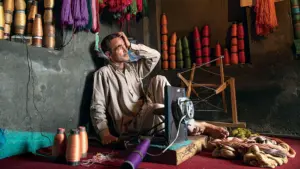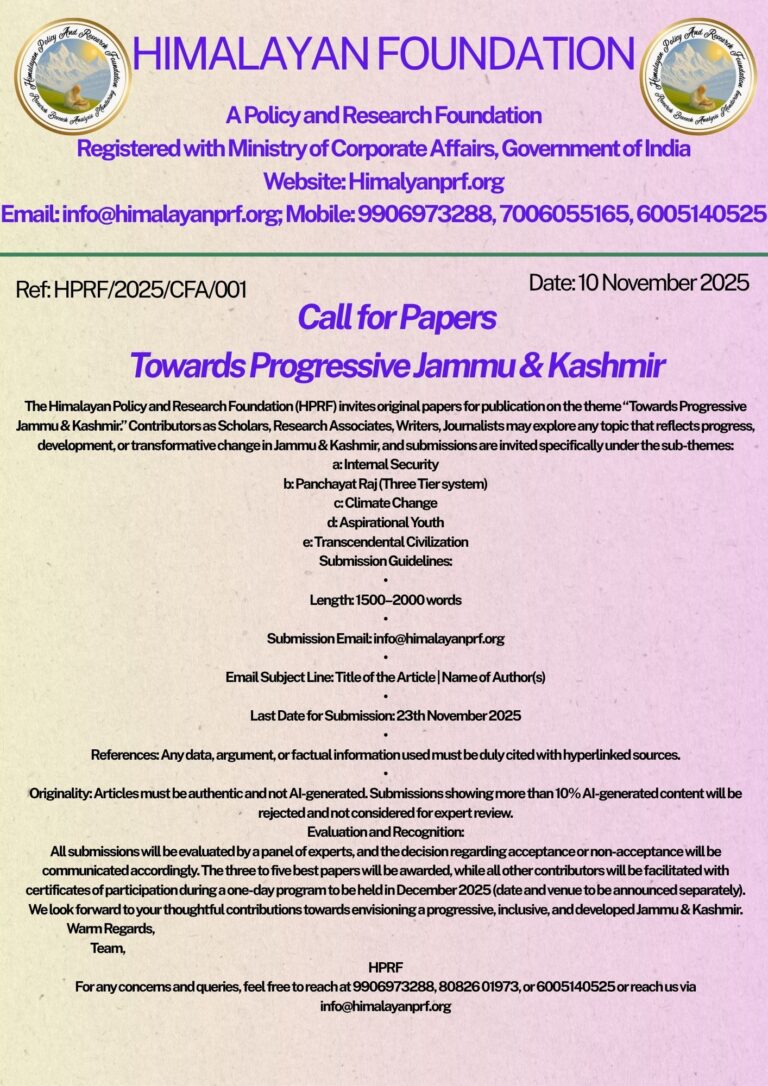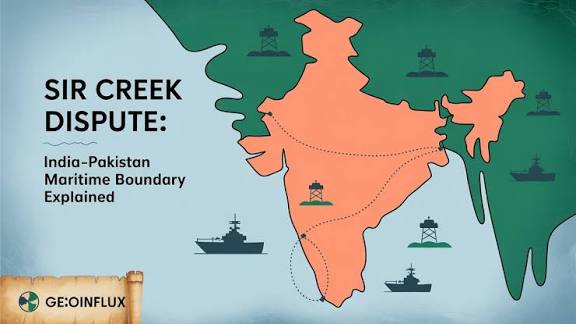Written by: Anusreeta Dutta
In Jammu and Kashmir, eating is more than just that. It’s a language that
shows who you are, what you remember, and how you subtly rebel. The
smells of boiling meat, the deep reds of heated gravies, and the light scent
of saffron-laced tea all show a culture and the things that are used to cook.
Kashmiri food is a reflection of the people’s past, their strength, and their
strong sense of who they are. This area is often defined by conflict and
geopolitics.
A Feast That Speaks: Wazwan’s Political Identity
The history of Kashmiri cuisine is strongly linked to the tradition of Wazwan, a large
multi-course banquet that is an important aspect of Kashmiri culture. Wazwan offers
more than just wedding and festival meals. Wazas, or master chefs, have been
producing it for decades. It is a ceremonial gesture that indicates that things will
continue to progress even when circumstances are awful.
The foods, which include saffron, cardamom, fennel, cloves, and the famous red chili
powder called deg, show how cultures have mixed over the years. Persian, Central
Asian, and Mughal flavors have come together perfectly with local Himalayan
ingredients to make a cuisine that is both beautiful and deeply rooted. Rogan Josh,
Yakhni, Gushtaba, and Rista are some of the most famous dishes that bring back
memories of royal courts, Sufi traditions, and trade routes that used to go through the
Valley. But the way they are made and performed now tells a different story: one of
keeping cultural identity alive in an uncertain present. Everyone follows the rules when
making wazwan. These rules include washing their hands in copper containers (tasht-e-
naer) and sharing a big plate (trami). Every gesture is a sign of a cultural norm or a
sense of belonging to a group. Being a part of a wazwan makes you feel like you belong
to a group. Food brings people together in a gentle way in a place where political stories
are often broken.
Spices as Symbols: Each Ingredient Has a Memory
You need to know the spices in Kashmiri food to understand it. The saffron, red chile,
and cardamom that give the Valley’s food its flavor are more than just spices; they also
represent the Valley’s people, place, and climate. People call Pampore the “Saffron
Town of Kashmir” because it grows the best saffron in the world. People have been
farming here for more than 2,000 years. This golden spice is a symbol of Kashmiri
culture that is deeply connected to both farming and religious traditions. In the same
way, the strong red chile that grows in the area gives Kashmiri gravies their unique red
color. It isn’t too hot, but it smells great and adds color and warmth to the dish.
Every spice in a Kashmiri kitchen has a story: farmers working in fragile Himalayan
ecosystems, trade caravans crossing mountains, and grandparents passing down
secret mixes. When the outside world tries to change the stories about Kashmir,
keeping these food traditions alive is a quiet way of saying, “We are still here.”
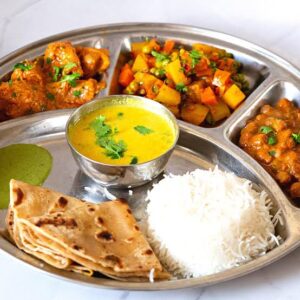
Food Under Occupation: Quietness and Assertion
Culture often becomes a battleground in places where there is war. For decades, the
Valley has been marked by political conflict, militarization, and competing nationalist
stories. In this kind of situation, Kashmiri food has often been a small but powerful way
to fight back.
People don’t make their case with loud slogans; instead, they do things like making
wazwan at weddings with traditional copper pots, insisting on local saffron instead of
cheaper substitutes, and making kehwa as part of winter hospitality rites. These
customs say that we should keep our traditions.
In Srinagar’s markets, people often talk about both food and politics at the same time.
When saffron prices go up and down or the weather affects crops, these are more than
just economic changes; they also affect cultural continuity. Families that store dried
vegetables (hokh syun) for the long winters are not only saving food, but they are also
practicing self-sufficiency that has been around for hundreds of years. This is work on
identity. It means that culture stays strong even when things are unclear.
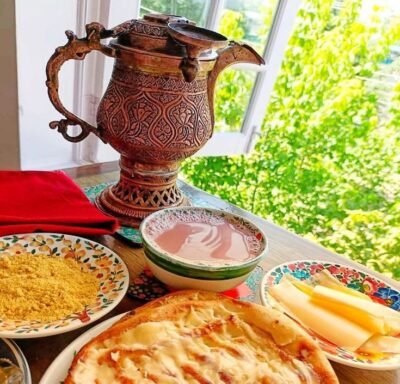
Kehwa: Hospitality as Defiance:
If wazwan is a great celebration of assertion, Kehwa is a daily ritual of silent opposition.
Kehwa is green tea infused with saffron strands, cardamom, cinnamon, and, on
occasion, almonds. It is served in small, delicate cups with etched golden rims. It is the
first thing provided to guests, the last thing served after a meal, and the defining feature
of Kashmiri hospitality.
Serving kehwa in Kashmir is more than just a habit; it is a symbol of respect. Even
during curfews, disturbances, and hardships, kehwa makes its way to the table. The
ritual of heating water with spices, allowing the perfume to fill the room, then serving it
with grace expresses the idea that “our culture endures.” You can’t take away what
dwells in our kitchens.
The perfume of kehwa is frequently associated with weddings, community meetings,
and even quiet evenings in winter when snow falls outdoors. In some ways, it is the
Valley’s way of communicating to the rest of the world that we exist on our terms.
Women and the Kitchen: Sites of Power:
Much of Kashmiri cuisine exists in the home, where women are the primary keepers of
recipes and traditions. For millennia, Kashmiri women have passed down oral culinary
traditions that have never been written down, including spice mixes, seasonal
preservation methods, fermentation procedures, and festival feasts.
This household archive becomes a cultural bulwark. In many households, the
grandmother’s spice box establishes the family’s culinary identity. In the face of political
upheaval, these women maintain their memory and identity through regular acts of
cooking.
They’re also quietly adapting. When access to ingredients is disturbed, whether by
climatic change or governmental restrictions, substitutes and inventions occur, but
always in ways that preserve cultural grammar. This flexibility within tradition is also a
kind of resistance: adjusting without erasing.
Culinary Heritage and Diaspora:
Kashmiri food is not limited to the valley. Forced and voluntary migration has spread its
smells all over India and the world. Kashmiri immigrants in cities like Delhi, Pune, and
London recreate wazwan in their homes and restaurants, keeping a part of their culture
alive through food. Feasting was both an elaborate rite and a celebration during
traditional Kashmiri Pandit weddings prior to 1990. Guests sat in orderly rows, and food
was served in seated queues, fostering a sense of community. The wedding feast
featured a range of delicious and fragrant vegetarian delicacies, including Dry Gucchi,
Dam Aloo, Red Paneer, Rajma Makhni, Nadroo Yakhnee, Kadam Saag, and Dahi
Payala. These dinners, which were frequently cooked with care and precision, reflected
the Valley’s seasonal food as well as its residents’ culinary identity. Just as wazwan
defines Kashmiri Muslim feasts, these vegetarian buffets held significant cultural
significance for Kashmiri Pandits. Equal emphasis on Hindu and Muslim marriage
ceremonies exposed the region’s shared culinary past, in which food became a modest
but strong language of identification and connection.
Food brought back memories for Kashmiri Pandits who left the Valley in the early
1990s. Some of the foods that were kept in exile were Dum Aloo, Modur Pulav, and
Nadur Yakhni. They were often more accurate than other cultural activities. When
landscapes were lost, food helped people feel better and passed on their culture to
future generations.
For younger generations who were born outside of Kashmir, learning these recipes is
often a way to remember their roots. Second-generation migrants frequently comment,
“I learned to cook wazwan to feel closer to home.” The kitchen becomes a site for
cultural recovery.
Globalization, commercialization, and the quest for authenticity
Like many native foods, Kashmiri food is being hurt by globalization in two ways. More
and more restaurants in India and other countries are serving “Kashmiri dishes,” but the
recipes are often changed or made easier. Rogan Josh may be served without its
trademark Kashmiri chili, and kehwa without saffron. These versions may be popular,
but they lack cultural substance.
Local chefs and culinary activists in Kashmir have begun to claim authenticity as a
method of resistance. Food festivals, culinary classes, and documentation projects seek
to recover the narrative from commercial dilution. By insisting on traditional procedures
and ingredients, they defend not only recipes but also cultural ownership.
This battle for authenticity is about more than just taste; it is also about controlling
cultural representation. In a place where external narratives frequently take precedence,
safeguarding the integrity of food is another way to reclaim the tale.
Cuisine as a Political Text.
In Kashmir, food is an unspoken but powerful political text. When families gather for
wazwan and kehwa is served in beautiful cups, or when farmers grow saffron despite
changes in the weather, these are all ways of affirming their culture. They are
statements of continuity, identity, and belonging.
Kashmiri food shows the world that there is a living, breathing culture that fights to stay
alive through everyday activities in a place that is often only known for conflict. Food is
like a map and a memory at the same time; it helps us remember things we can’t lose.
The story of Kashmiri food is not one of passive tradition, but of active, everyday
resistance. Spices have stories, foods have identities, and kitchens become places of
power. The scent of saffron and the red of Kashmiri Chile send a message: our culture is
strong, not weak.
Kashmiri food keeps expressing itself, whether it’s in the Valley, in migrant kitchens, or
on tables around the world. That might be its best feature. Food lasts when words don’t.

————————————————————————————————————
About the author:
Anusreeta Dutta is a columnist and climate researcher with prior experience in political
research and ESG analysis.




